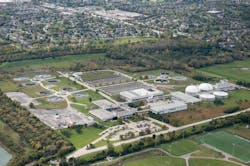Egan Water Reclamation Plant Celebrates 40 Years of Service
The John E. Egan Water Reclamation Plant (WRP) in Schaumburg, Ill., turns 40 this month, and its history of improving local water while setting trends in resource recovery projects make it an asset to the Metropolitan Water Reclamation District of Greater Chicago (MWRD) and residents of the northwest suburbs.
The Egan WRP, which serves the communities of Schaumburg, Arlington Heights, Elk Grove Village, Hoffman Estates, Inverness, Palatine, Rolling Meadows and Roselle, has been in operation since Dec. 16, 1975. Seven years after it came into service, the U.S. Environmental Protection Agency selected the Egan WRP as the "best operated and maintained" large plant in Region V. The plant incorporates advanced secondary treatment along with tertiary filtration for the removal of waterborne pollutants. The facility treats on average of 30 million gal of water per day and can treat as many as 50 million gal per day at capacity.
Today, the plant has established initiatives in renewable energy resources, and has also developed a way to lessen the impact of phosphorus and nitrogen on waterways by removing ammonia in the treatment process.
"We are proud of 40 years of commitment to transforming and protecting our water quality at the Egan Water Reclamation Plant," said MWRD president Mariyana Spyropoulos. "Every day, our 75 staff members at Egan work hard to meet the demands of treating tens of millions of gallons of water in a most environmentally and efficient way that allows us to reduce our energy usage and create new opportunities through resources collected in the treatment process."
The National Association of Clean Water Agencies awarded the Egan WRP earlier this year with a gold award for meeting 100 percent compliance with National Pollutant Discharge Elimination System (NPDES) permits for an entire calendar year.
At the Egan WRP, water is disinfected using chlorination and dechlorination, and there are tertiary filters made of dual media of sand and anthracite for further polishing of solids. The clean water is released from the Egan WRP into Upper Salt Creek. After 7.8 hours, the Egan WRP can transform sewage to clean water.
In its pursuit of energy neutrality, the MWRD installed a solar thermal project to convert solar heat into usable hot water at Egan. MWRD has installed 45 solar panels, donated by the city of Chicago, through an intergovernmental agreement, and installed the panels with grant assistance from the Illinois Department of Commerce and Economic Opportunity. These panels generate 2,040 therms annually. The system provides preheated boiler make-up water and other hot water needs at the plant. As a result, MWRD can lower natural and digester gas usage in the steam boiler system and saves non-renewable energy usage and cost; reduces emission of greenhouse gases and pollutants; and serves as a model technology for possible use in other applications.
As part of the water treatment process, the MWRD also upgraded a dewatering facility at the WRP to provide increased storage capacity for biosolids, add a close conveyance system to address odors and improve the system's reliability. The Egan WRP continuously works to improve efficiency by automating chemical intensive processes like disinfection and sludge thickening as well as lowering energy usage in secondary treatment.
In conjunction with the agency's goals of implementing green infrastructure to meet increasing demands for storm water management, the MWRD is scheduled to replace the parking lot in 2016 at Egan WRP with new permeable pavement to provide several benefits. The new lot will improve water quality, groundwater recharge and delayed discharge of storm water to the receiving waterway.
Source: Metropolitan Water Reclamation District of Greater Chicago
